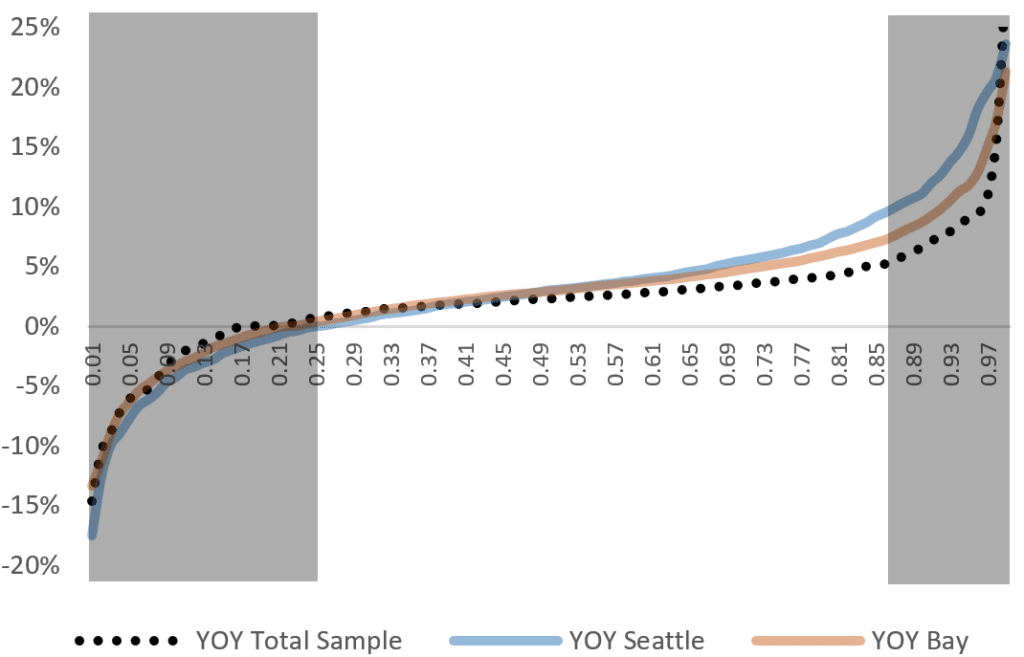An Argument Against Pure Market-Based Salary Compensation Structures
Salary Structures and pay bands are tools widely used by compensation practitioners to ensure that Organizations are paying roles competitively in the labor market, while maintaining internal equity within the organization. While the vast majority of organizations target paying a specific market percentile for their roles, there are a variety of approaches that can be used:
- Traditional Salary Structures
- Broad Band Salary Structures
- Purely Market Based Salary Structures
- Step Scales
While no single solution will work for every organization, this paper explains why purely market-based compensation structures should be abandoned.
2021 Should be the End for Pure Market Salary Structures
At the time of this publication, the US inflation rate of 6.8% is the highest level in nearly 40 years. The labor market is more competitive than ever due to greater hiring and fewer job seekers and traditional salary survey are simply not able to keep up. Even evergreen surveys or quarterly salary surveys aren’t enough to ensure a competitive stance. This is a unique circumstance where benchmarking against what other companies are paying is still not enough to ensure a competitive stance against what companies are willing to pay. What companies are willing to pay, as opposed to what they are paying can be a very valuable tool to assess hiring and retention challenges.
Market Data is Imperfect
The availability of market data has not always been as prevalent as it is today. As the availability of market data has become more prevalent, so too have companies’ reliance on that data. It is my opinion that a large portion of organizations rely on that data too heavily, unaware of the problems with the data. Organization’s that use a pure-market-based salary compensation structure will see these problems permeate through their ability to pay competitive wages, develop meaningful career paths, and manage their human capital budgets year-over-year – not to mention be less efficient in their efforts to ensure a competitive stance in the market, overall.
There are Legal Limitations to the Market Data
Salary survey data is limited by Anti-Trust rules:
- Data must be at least 3-months old
- No fewer than 5 companies may participate
- All data must be anonymized
- No single company can account for more than 25% of the data
Market Data is Always Incomplete
Employer reported salary surveys are arguably the most accurate data source available to find a job’s market value. Consider, however, that salary survey participation is typically the responsibility of a Compensation Analyst – a role that typically is only found in larger organizations. As such, organizations that are not large enough to have a dedicated compensation professional are underrepresented in the salary surveys. As such, one can assume that employer reported market data excludes a large percent of employers – capturing only a small segment of the market.
The market data is even more incomplete for organizations that market price their roles against a particular industry or revenue cut – which may not be fully representative of where they are actually competing for talent.
Pure Market Based Salary Structures Are Not Necessarily Competitive
The job of the compensation practitioner is not to simply align a job’s midpoint to market data. Compensation Practitioners must use their discretion to assess the validity of the market value, the quality of the matches, and then must decide how to best support the business – balancing fiscal prudence and the ability to retain talent.
Especially in the past 18-months, we have seeing meteoric rises in what companies are willing to pay for new talent. Companies that are overly reliant on traditional salary surveys are unable to remain competitive because the data is old. The data no longer reflective of what it means to be competitive against competitors.
Traditional pay structures (and even broadband compensation structures) are sheltered from this lack of competitiveness because the pay ranges allow for companies to pay within a range that is not constrained. This kind of flexing is more difficult for purely market-based pay structures – especially when they target the 25th – 75th percentiles as their pay ranges.
In the current economic and labor market conditions, pure market-based pay structures will continue to undervalue the current labor market due to the timeliness of the salary survey data. The impact on the old market data may be significant as seen in the image below, which comes from Compensation Tool’s Squirrel. Squirrel is a database with millions of job postings that include hiring salary ranges. With Squirrel, we are able to monitor wage trends. The image below shows the tremendous wage growth in Baristas providing empirical data that , pay ranges positioned against salary survey data may greatly reduce the Organization’s ability to maintain a competitive stance because companies are willing to pay new hires 10% – 15% for the same job 6-months ago.
Market Data is Volatile
One of the greatest problems with pure market-based approaches that is often ignored is that the market data changes every year. Sometimes dramatically. Sometimes unexpectedly.
In 2018, I evaluated the year-over-year market movement of the jobs in a large technology survey used by thousands of Companies in the US. The results were surprising: the market median of 25% of jobs either stayed the same or decreased in market value from 2017 to 2018 in the Seattle market. Conversely, 13% of jobs increased more than 10% in a single year. The combination of jobs that decreased and jobs increased more than 10%, accounted for nearly 40% of the job catalogue. Forty percent is a material percent of jobs experiencing questionable annual volatility. Those jobs are highlighted in the grey boxes in the image, below.

With this in fluctuation in mind, I conducted on LinkedIn, asking how companies updated their ranges if the market data decreased in one year. More than 200 compensation analysts from companies in the US responded. Of the 200 responses, 95% of respondents stated they do not decrease pay ranges, even when the market data recommends it. This disregard for the data in a “pure market-based” compensation structure is one core problem that undermines the validity of a pure market-based approach.
Note: While I am not suggesting that pay ranges should be decreased, this is a crux of my argument against using pure market-based structures. In their truest sense, pure market-based structures leave little room for discretion and there is nothing “pure” about the structures when companies disregard the data that doesn’t align to expectations.
Market Data “Misbehaves”
Generally speaking, the market value increases 15% – 25% each level within a professional role of the discipline (my research suggests it’s around usually about 21%). However, depending on the quality and quantity of the survey participants – sometimes we even see either very little increases, or astronomical increases between job levels. No compensation analyst worth their salt would suggest that a 3% promotion from a P1 to a P2 is a good idea. Conversely, a 30% jump from a P3 to a P4 may be cost prohibitive and financially irresponsible. However, both micro and massive jumps exist within our surveys – especially when the sample sizes are small.
There are also some surveys job families that have found a Senior Director to be paid less than a Director of the same profession. Aon describes these situations as the “data ‘misbehaving’” and suggests it is our responsibility to decode the data, rather than take it at face value. I fully agree with Aon and applaud that they directly acknowledge this type of situation.
Despite its Flaws, Employer Reported Salary Surveys are Still the Best Data We Have
Although we’ve spent considerable time discussing the imperfection of employer reported market data – it is important to reiterate that employer reported salary survey data is extremely important and must not be cast aside. Employer reported salary surveys are the most reliable, most validated and usually the most robust data available to us.
I am not (at all) advocating that we cast employer reported surveys aside, but merely bringing attention to the importance of the “art” of compensation. Applying discretion is a key characteristic of a highly successful compensation professional.
Internal Equity is Neglected
As I mentioned, one of the cornerstone concepts of Compensation is that it is a blend of art and science. I would suggest that the benchmarking and market data is the science, and career pathing and internal equity is the art.
Pure market-based pay practices deprioritize the importance of career pathing, internal equity and business needs, and solely prioritizes what the market data states.
Pay Is Inconsistent
Pure market-based structures have little to no consistency, varying considerably per job and per year. Organizations that use percentile markers (such as the 25th and 75th percentile) to establish the pay ranges forfeit their ability to create meaningful career paths, distinguish performance of high performers with pay, or potentially to recognize tenured employees without unnecessary promotions.
Traditional salary structures are market based typically have salary range spreads from 20% – 40%. For many Companies, employees’ position in range may drive performance-based merit increases. In a pure market-based structure, inconsistent ranges may mean that some employees are treated differently than others, due to some jobs having wider or narrower ranges based on market data. Another benefit of traditional (or similar) structures is the controlled overlap of pay ranges allowing for tenured and skilled employees to improve their salary when a promotion is not warranted by a business case.
The inconsistency spans beyond just the ranges. As mentioned previously, inconsistency in the year-over-year growth may also mean that employees paid high in the range one year, may be red-circled the next year – purely due to changes in the survey data and the participants – rather than true market forces.
The Approach can be Costly
Depending on your current range spread, narrowing your bands to meet certain percentiles can carry a considerable cost when we move employees into the pay range – as compared to a salary structure that is not purely market based.
In my personal research, I have found that typical salary ranges may span 30% – 50%, whereas the median range spread from the 25th to the 75% percentile is only 29%. In fact, only 17% of jobs have a spread of 40% or more, from the 25th to the 75th percentile. This compression of the ranges means that there is a greater cost to move employees into pay ranges, from previous job levels.
Although the theory is noble and sounds like an exceptional approach to maintaining a competitive stance, the reality is flawed.
Benefits of Pure Market-Based Salary Structures
There are some benefits to pure market-based structures, but I argue that the benefits are rooted in optics and corporate politics more than improving the Organization’s market competitive stance.
I once took a role with an organization that had an office in the San Francisco Bay area with a 12-month rolling turnover rate of nearly 50%. Unsurprisingly, management cited poor pay as the culprit and consistently asked “did you price the job for the Bay?”
Without understanding the impact sample size has on the market data, nor how survey data specific to high-cost of labor markets doesn’t guarantee that the value of the job will be higher than the total sample. Leadership and managers would always cherry pick the data that fulfilled their beliefs and ignore the data that wasn’t as expected.
Using a pure market compensation structure, I could confidently say “Yes, I reviewed this job for this specific market and can say with certainty that this job’s salary range is completely tied to local salary survey data.” That was the most tangible benefit, and it would last until the new survey results came out. This is a perfect example the tail wagging the dog.
To manage this expectation, I used the reasonable approach of comparing both the national data, the local data, and then using my discretion to place the jobs in the pay band that was both competitive and internally equitable. If the data was not as expected or felt misaligned, I would consult with our business partners to ensure we were making good decisions (this is very easy to do within the Compensation Tool).
Summary
One of the most common reasons I hear Organizations suggest they can’t change from a pure market-based structure to a traditional structure is because the “business is a data driven business” or “leaders want to see the data.” Phooey.
I have a strong hunch that, although leaders want to see the data, they probably don’t see all the data – especially if it doesn’t support their misguided belief in the market data being the savior of a competitive. While selection bias of the market data can improve its acceptance by leadership, it will create greater challenges for the organization with to recruit, retain and engage employees.
Having a traditional salary structure does not preclude sharing data with stakeholders and leadership. I would often enter job family reviews with business leaders that were nervous about the process and lack of flexibility from HR. In every kick-off meeting, I would explain: “I’m not here to make our jobs line up to market data; my job is to make sure you’re able to hire competitively.” This sentence always caused a palpable shift in the room. Sometimes there was a collective sigh of relief. The stakeholders knew I was there to support them, not block them.
While some discretion can be applied using a pure market-based structure, a traditional compensation structure is far simpler to maintain, easier to explain, and allows for considerably improved internal equity.



No responses yet